

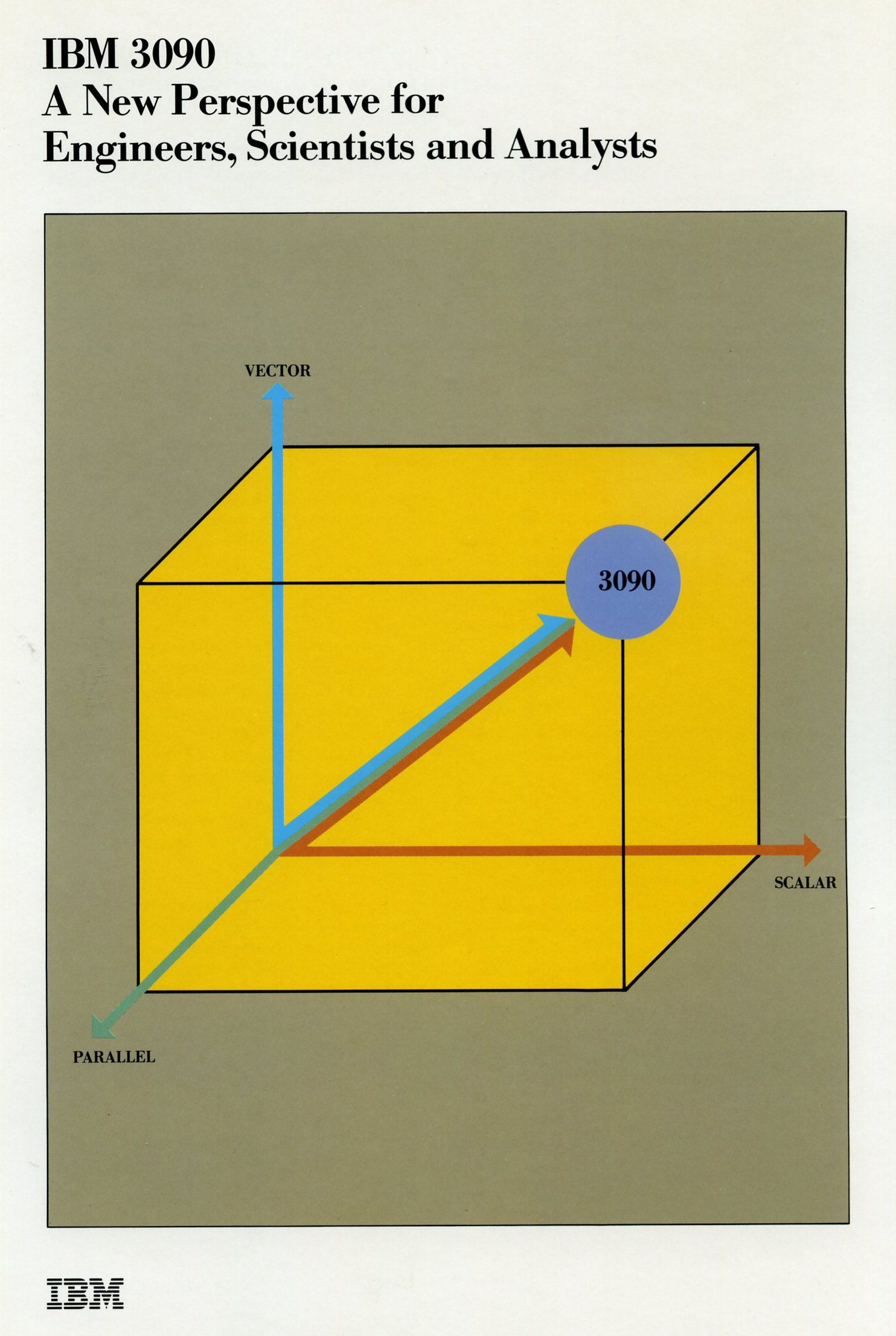
From its conception the IBM 3090 has been designed for you, the engineer, scientist or analyst, to satisfy your need for greater computational power. In developing the 3090, IBM has provided scalar, vector and parallel computing capabilities to enable users to optimise individual job turnaround and total systems performance.
Virtually all programs require scalar processing which is why the IBM 3090 has built into it specialised hardware attributes to make it one of the fastest scalar computers available today.
Onto this scalar foundation IBM has added an optional vector processing capability, giving to user with highly iterative code (FORTRAN program with a high proportion of DO loops or APL programs which manipulate arrays) the opportunity to obtain a major performance improvement at a low incremental price.
For both scalar and vector applications where many independent calculations are involved, the IBM 3090's multiprocessing design (with up to six central processors in the Model 600E) coupled with the IBM VS FORTRAN Program Multitasking Facility, permits you to split a single program into multiple tasks. The tasks may be run in parallel on all the central processors, producing major turnaround improvements for some long running programs.
All this computational function and performance is provided in one system under the control of a single system control program. Scalar, vector and parallel computation can be intermixed and the same data files can be shared by different programs or users as required.
For FORTRAN users, the same powerful IBM VS FORTRAN Version 2 Compiler provides highly optimised scalar or vector code. Vectorisation is performed automatically when selected. In both cases, IBM-supplied subroutines provide state-of-the-art accuracy and performance.
For APL users, APL2 provides powerful interactive capabilities including access to relational data base and graphics software. Now, whether employed for application prototyping or production work, APL2 can directly invoke use o[ the Vector Facility, as a run-time option without any need for code modification.
Many IBM and non-IBM application packages are available to help you implement the systems you need on the IBM 3090, including non-IBM vectorised code for structural analysis, fluid dynamics, dynamic simulation and mathematical subroutines. The latest European IBM catalogue of scalar programs available from non-IBM source lists over 250 products.
The IBM 3090's multiprocessor design, providing up to six central processors and six vector facilities, gives you a wide range of choice to match your processing requirements today and to handle your growth in the years ahead.
Using innovative Thermal Conduction Module (TCM) packaging technology, a memory design with excellent automatic error correction and an online Remote Service Facility for maintenance, the IBM 3090 is designed to provide enhanced availability.
Operating under IBM's System/370 Extended Architecture and System/370 Architecture, the 3090 continues a tradition, which goes back over 20 years, of providing compatibility with previous IBM large computers; permitting you to invest in IBM hardware and software with confidence for the future.
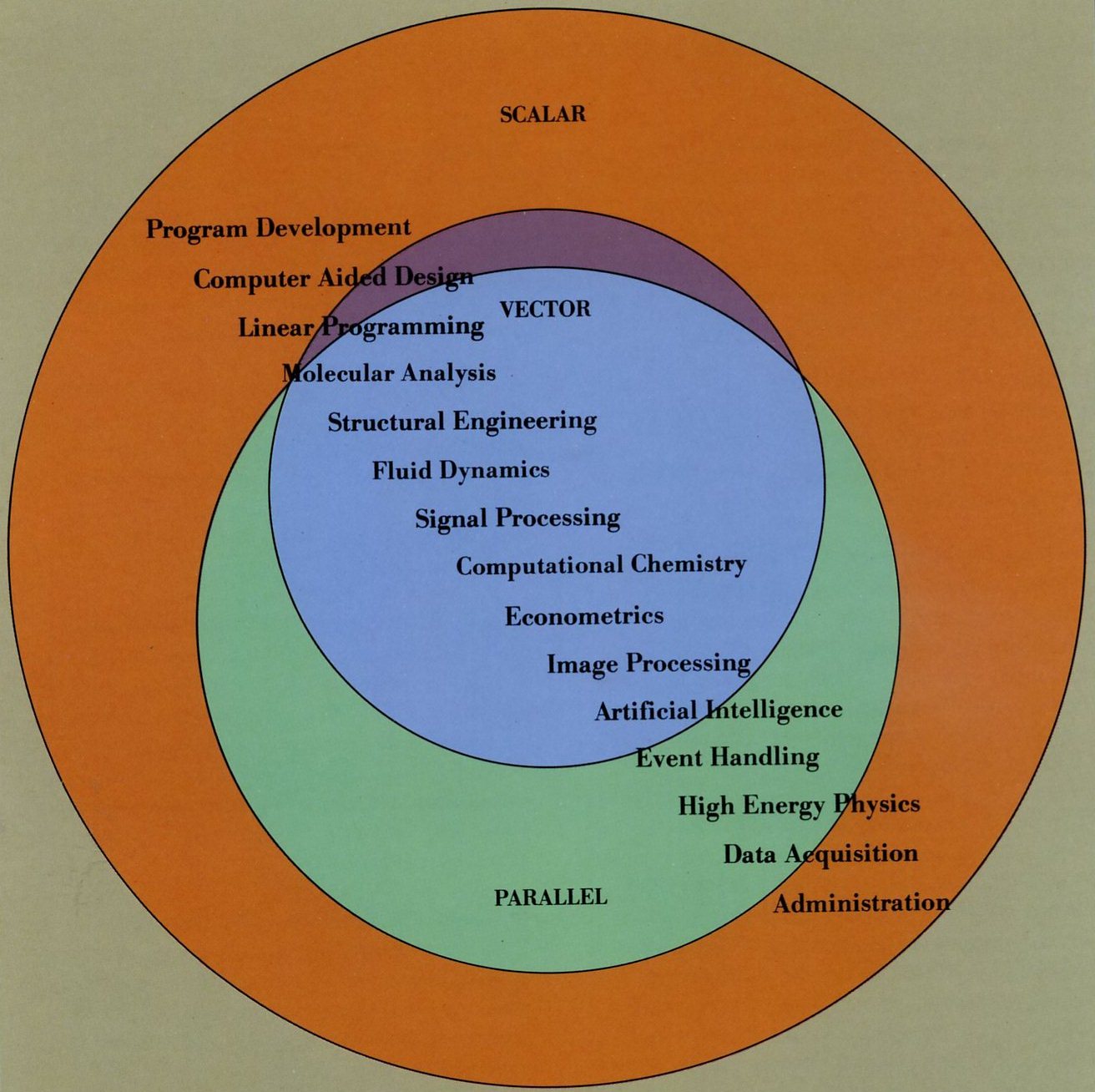
Whether your field is engineering design or geophysical exploration, government research or higher education, economics or statistics, computer are being used more and more to solve problem and to develop new products.
As computer price/performance continues to improve, so does the sophistication of the computer techniques used by the engineering, scientific and analytical community. In business, analysts are turning to computers to predict currency and share price movements in a global financial market.
In manufacturing industries, cost and competitive pressures are causing engineers to supplement wind-tunnel testing and vehicle crash trials with computer simulation. Elsewhere computer provide the only acceptable solution. For example, in oil reservoir modelling, estuary simulation and astrophysics, direct physical experimentation is either not feasible or inaccurate; in seismic processing and defence applications, the best attainable results justify the investment; and in circuit design and solid modelling, only computers can handle the complexity.
The IBM 3090 has been designed to provide the numerically intensive computing solution to your growth requirements; it combines in a single integrated system all the facilities needed to obtain outstanding performance in all application areas.
Two computing techniques provide engineers, scientists and analysts with a major opportunity to improve job turnaround, examine more alternatives, use more refined models or embark on new areas of study. These techniques, parallel and vector processing, offer performance gains which far outstrip those available just from developments in computer switching speeds. Both are available with the IBM 3090.
In most computers, one instruction operates on only one data pair and one program executes in only one processor at any given moment. This is traditional scalar processing.
Vector processing permits a single computer instruction to perform the same operation on many data pairs in swift succession. Parallel processing permits a single program that can be split into independent elements to be executed by separate processors in a multiprocessing computer simultaneously.
Each of these techniques used on its own can provide significant performance improvements. When combined on an IBM 3090, even greater performance improvements are possible.
Good scalar performance is essential, not only for those programs which cannot be vectorised, but also for those which can. Even vectorised programs can contain significant sections of scalar code. That is why IBM started by designing the 3090 to be one of the fastest scalar computers available today.

The IBM 3090 provides outstanding scalar performance for compute-intensive application through a combination of architecture, technology and design which optimises the processor unit's performance for integer and floating point calculations. As with previous System/370 and system/370 Extended Architecture processors, the IBM 3090 retains a comprehensive commercial processing capability.
The general purpose instruction set of the IBM 3090 contains 212 scalar instructions including 52 scalar floating point instructions. These provide the capability of performing 32-bit integer and 32-bit (short), 64-bit (long) and 128-bit (extended) precision floating point operations. The number range supported by the IBM 3090 hardware is from 10=76 to 10-77 which can be extended by IBM software from 10+9861 to 10-9865. The floating point formats permit a precision of from 6 to 7 decimal digits operating with short precision, to 32 to 33 decimal digits operating with extended precision. Error checking is used throughout the IBM 3090 processor complex and its attached IBM input, output and storage devices.
A separate channel subsystem for handling Input/Output (I/O) and a system control element for handling accesses to shared central and expanded storage leaves the central processors in an IBM 3090 free to concentrate on program execution. Execution of compute-intensive programs is enhanced by special hardware in all the central processors. This includes a hardware multiplier, optimised add/subtract logic and special loop control circuitry to improve execution performance. Overlapped instruction and execution elements within each central processor provide a highly efficient environment for scalar computation.
IBM System/370 Extended Architecture and the storage hierarchy of the IBM 3090 combine to give the engineer, scientist and analyst a liberal programming environment under MVS/XA. Each program may occupy a virtual address space of up to 256 Megawords (Mw) or 2048 Megabytes (Mb). Within the 3090 up to 160 Mw (1280 Mb) of processor storage provide fast access to data and minimise paging to I/O devices. Use of a three-level storage hierarchy, which is transparent to the programmer, minimises cost and maximises performance. Each central processor has its own 8 Kw (64 Kb) high speed buffer by which most requests for instructions and data are satisfied. Often, all the data needed to solve a large problem can be retained in processor storage for the duration of the job, eliminating intermediate input/output operations and dramatically reducing turnaround time.
64-bit data paths are used throughout the IBM 3090 Processor Unit. Up to 96 channels, each of which can operate at up to 3 Mb per second, provide balanced I/O performance for the powerful IBM 3090 central processors. Operating in System/370 Extended Architecture mode, up to four channel paths may be assigned to each I/O device and any path may be selected for each I/O operation. This permits a high level of channel utilisation without loss of performance and can ensure that fast response is obtained from heavily utilised disk file such as program libraries and data bases.
This all adds up to a computer with exceptional scalar performance which has been confirmed by independent measurements. The MacNeaJ-Schwendler Corporation provides a booklet entitled "Time Estimation and Problem Execution" with MSC/NASTRAN. The August 1986 edition shows that the IBM 3090 Model 200 executes the MSC/NASTRAN multiply-add-loop faster than any other non-vector computer listed in the publication.
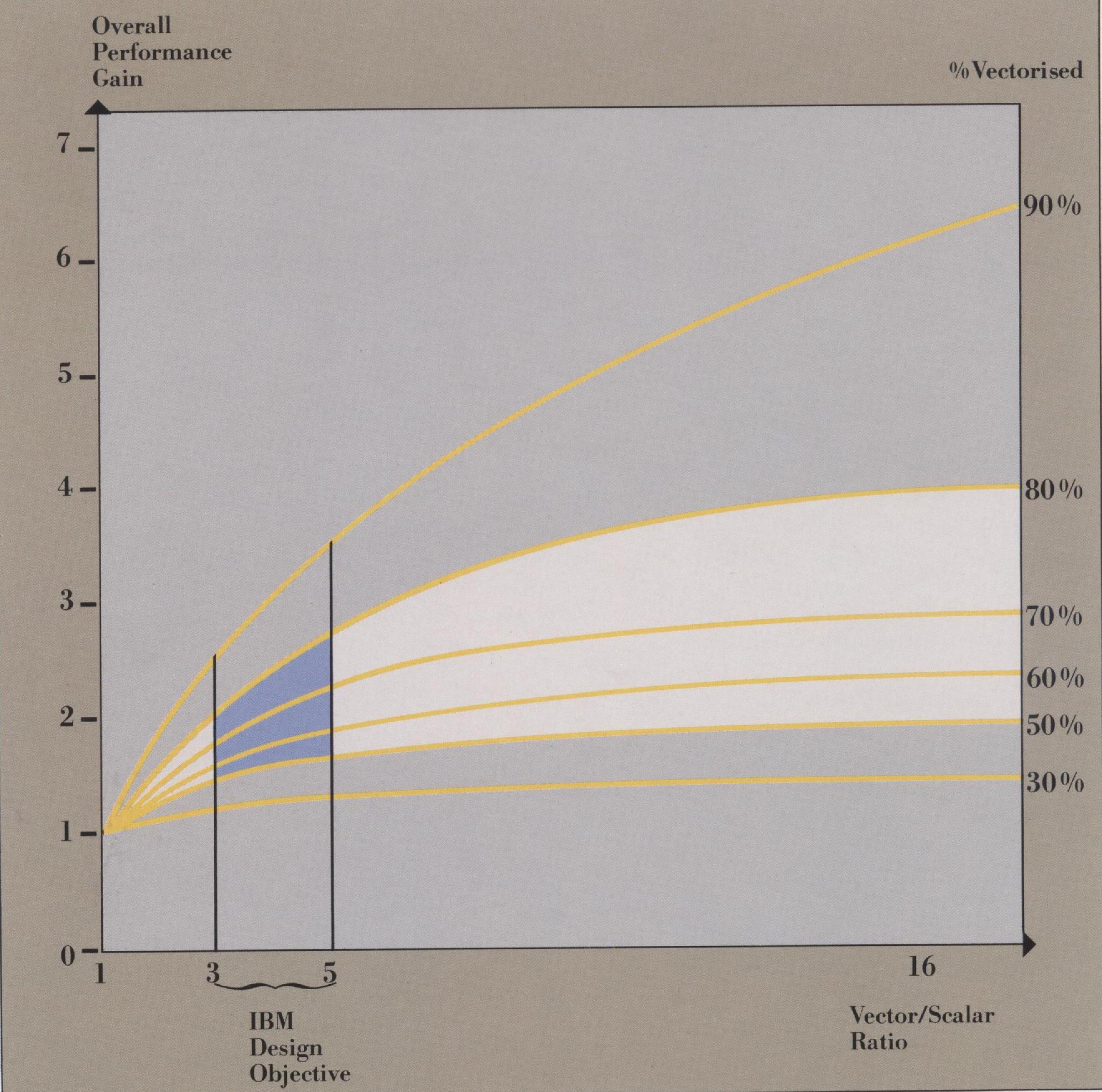
One optional field-installable Vector Facility can be added to each central processor in an IBM 3090 Processor Unit, providing up to six facilities on the largest Model 600E. Each Vector Facility forms an integral part of the central processor to which it is attached, providing an attractive performance option with a low incremental price.
Even in cases where high levels of vectorisation are theoretically achievable, practical consideration frequently result in achieved levels of vectorisation in the range of 50% to 80%. Since the faster execution offered by vector processing only affects the vectorised portion of a program, the law of diminishing returns applies when very fast vector processors are used for programs with low to medium levels of vectorisation. In such cases, scalar performance is equally or more important. The IBM Vector Facility has a design objective of three to five times faster than the scalar performance of the central processor. This, as the diagram shows, provides significant improvements in the range of one-and-a-half to three times 3090 scalar performance for typical vectorisable applications on those models.
171 additional instructions are supported by the Vector Facility, increasing the IBM 3090's instruction set to 383 instructions and providing an exceptionally broad spectrum of machine level capability. Each Vector Facility includes a vector execution element and a set of vector registers. The registers, which contain 128 elements, can be used as sixteen 32-bit registers or eight 64-bit register for integer and floating point arithmetic. The ability of the registers to hold up to 128 vector elements is expected to be optimum for many applications. When vectors exceed this length, automatic sectioning is provided by the IBM VS FORTRAN Version 2 Compiler and the vector architecture. Flexible addressing options permit matrices to be processed by row or column taking each element in turn or randomly.
The pipelined vector execution element allow completion of one operation every cycle. For compound instructions, such as Multiply-and-Add, two operations may be completed every cycle.
Introducing vector processing with the IBM 3090 is very easy. All you have to do is recompile existing language level 66 or 77 IBM VS FORTRAN programs using the IBM VS FORTRAN Version 2 Compiler, which will result in the automatic generation of vectorised object code. This is because the Vector Facility is an integral part of the 3090 and current IBM VS FORTRAN and Assembler compilers have been extended to support the additional vector instructions. No changes to source code or files are required, though code modifications are likely to permit higher levels of vectorisation that will further improve program performance. According to user choice, program can be tested in scalar mode or with the IBM 3090 Vector Facility Simulator even before the Vector Facility is installed.
Taking advantage of the Vector Facility is even easier for APL user. The APL language is around the concept of array processing and is "vector ready." A performance analysis tool in PL2 permits identification of APL functions which will benefit from execution in vector mode. No code changes are needed to exploit the Vector Facility. Up to six-fold performance improvement have been measured for APL primitive functions.
Whether you introduce vector processing by adding Vector Facilities to an installed 3090 or by installing a new 3090 with ] Vector Facilities, it is cost effective. In both cases, mixed scalar and vector as well as commerciaJ work can be run on the same 3090. (Vectorised programs are automatically executed only on central processors which have vector capability.} In this way, the considerable asset that the 3090 computer with one or more Vector Facilities represents can be fully utilised. This is true even at the outset when few programs have been implemented.
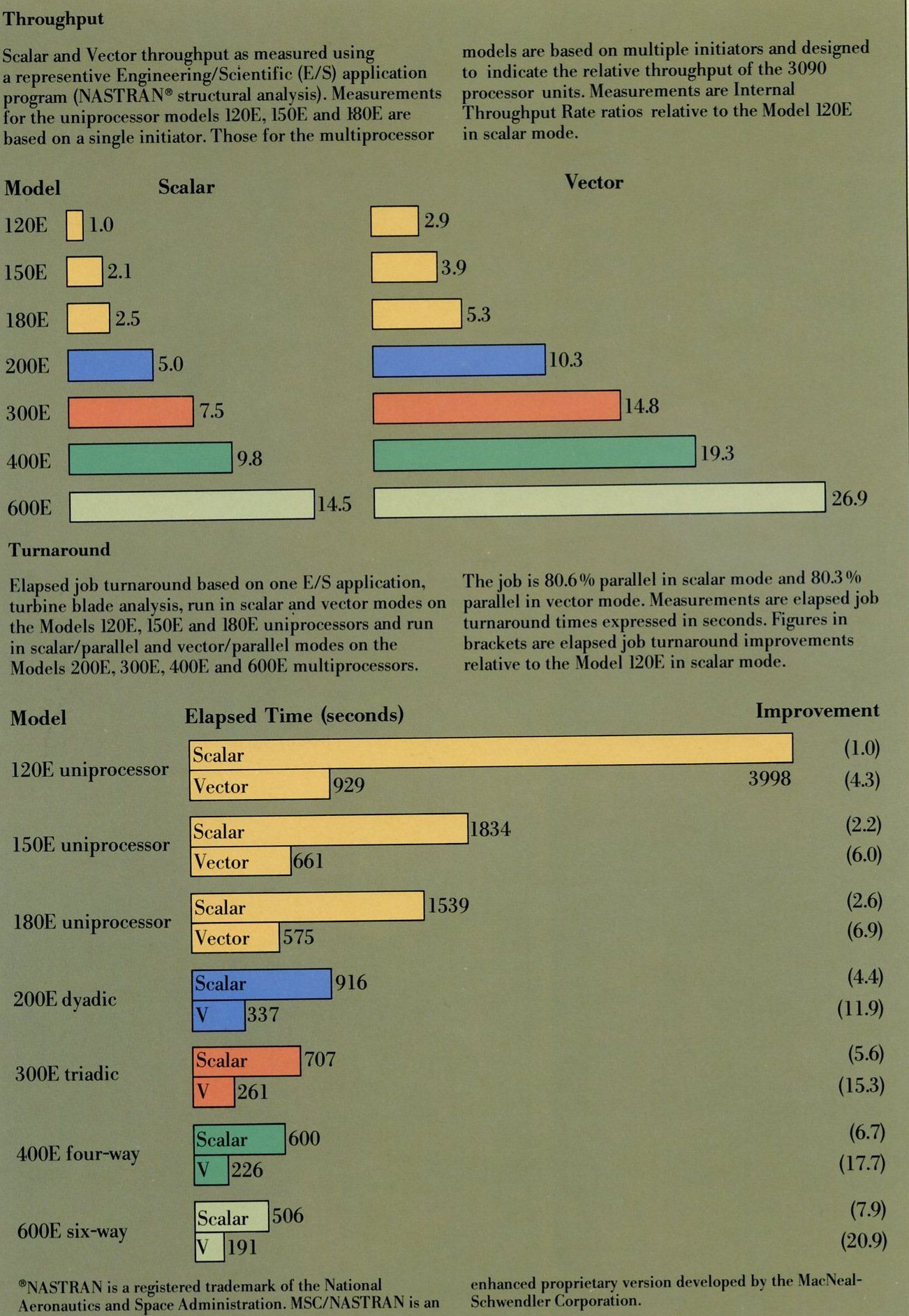
Electronic technology is a key factor affecting the rate at which individual processors can be made to run faster. Multiple processors are a means of obtaining greater performance: using multiprocessing to obtain greater aggregate performance and parallel processing to obtain greater program performance.
In multiprocessing a single control program allocates many programs to be executed on the processors making up the multiprocessing complex. A given program is executed on only one processor.
In parallel processing a single program may be divided into separate, independent tasks which are then executed concurrently on the different processors: providing the opportunity for significant program turnaround improvements, depending on the degree of parallelism in the program, the number of parallel processors available and the efficiency of the multi-processing design. Parallel processing is of particular interest for critical long-running job.
IBM has long recognised the potential limitations of a single processor computer design. IBM's first multiprocessor, the System/360 Model MP65, was introduced in 1968. Today, MVS/XA provides for up to six-way multiprocessing. With experience stretching back 20 years, IBM's range of 3090 computers embodies the design expertise needed to provide highly effective parallel processing and multiprocessing.
FORTRAN programmers can obtain the benefits of parallel processing using the Program Multitasking Facility in IBM's VS FORTRAN Version 1 and Version 2 Program Libraries under MVS/XA. Only FORTRAN calls are required to indicate the beginning and end of program sections which can be executed independently. During execution, the MVS system control program uses its multitasking capability to assign these sections to different processors and control the synchronisation requested by the programmer.
Parallel processing is not limited to programs which operate on vectors. Any scalar program where a significant amount of independent computation is required can also benefit. Some applications are more suitable for parallel processing than vector processing.
With both vector and parallel processing facilities available on the IBM 3090, compute-intensive users have the opportunity to obtain significant improvements in job turnaround. Performance gains of over 20 times have been measured with this approach, using six-way parallel vector processing instead of scalar processing on a single 3090 processor (as illustrated on the diagram above).
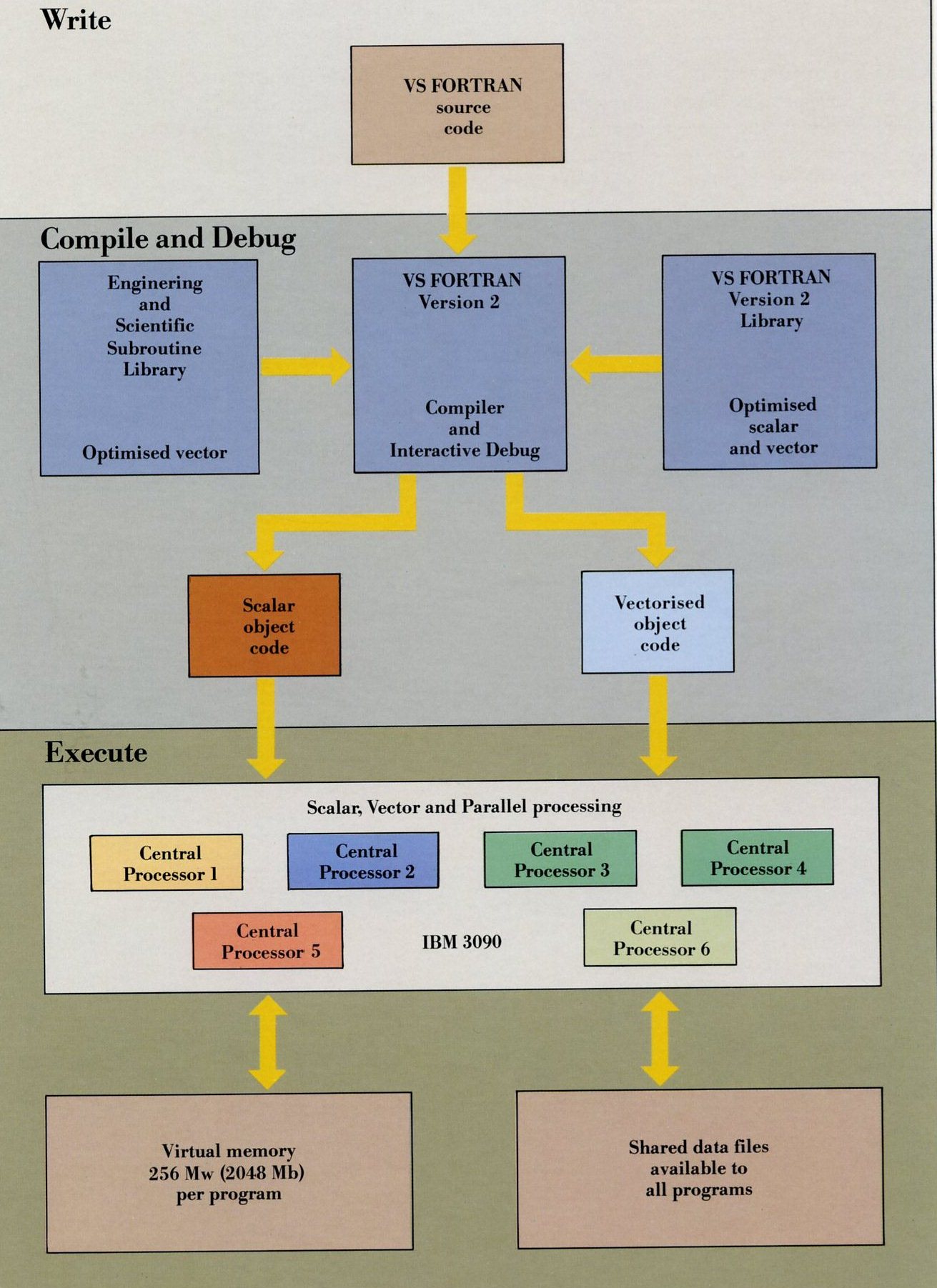
The IBM 3090 provides hardware for scalar processing, vector processing and parallel or multiprocessing in a single processor complex. Likewise IBM's system software support utilises a unified approach: one compiler provides FORTRAN object code for scalar or vector processing, in a parallel processing environment if required. One APL interpreter permits scalar or vector execution of the same APL functions. Four system control programs, MVS/XA, VM/XA Systems Facility, VM/XA System Product and VM/SP High Performance Option, support scalar and vector processing simultaneously in the same IBM 3090 processor complex.
MVS/XA exploits the IBM 3090's hardware and provides a liberal environment for end users and programmers. This includes a virtual storage capacity of up to 256 Mw (2048 Mb) for each program. In addition MVS/XA supports all six processors of the largest IBM 3090 Model 600E as part of a single logical system, minimising control program overheads and allowing FORTRAN user to perform six-way parallel processing with the VS FORTRAN Program Multitasking Facility.
The VM/XA Systems Product, VM/XA Systems Facility and the VM/SP High Performance Option all provide a virtual machine environment. Together with the Conversational Monitor System (CMS), they permit each end-user to access the IBM 3090 system independently, with the perception that he or she is the sole user. Communicating with the IBM 3090 via VM/CMS, Vector Facility users can develop, test and execute vectorised applications on line, using a comprehensive range of IBM Assembler, APL2 and FORTRAN languages, libraries and productivity tools. VM/HPO also provides guest System Control Program (SCP) support, not only for other IBM SCPs but also for IX/370, IBM's implementation of UNIX.
IBM's latest FORTRAN compiler is designed to enable the engineer, scientist and analyst to exploit the scalar, vector and parallel processing capabilities of the IBM 3090 easily. In a single product, FORTRAN Version 2, IBM provides state-of-the-art compilation to produce highly-optimised object code for scalar or vector execution, using the same source code. Language level 66 and 77 source code is accepted by VS FORTRAN Version 1, the currently available scalar version of the compiler. Both compilers include the FORTRAN Program Multitasking Facility, permitting parallel execution of programs.
Recent vectorising compiler enhancements include the provision of Directives, a CPU Sampling Facility (hot spot analyser), interactive vectorisation and the support of 31-character symbolic names.
To provide the engineer, scientist and analyst with efficient code for the execution of widely-used mathematical functions, there are FORTRAN library products for both scalar and vector processing. The VS FORTRAN Version 2 Library contains highly-tuned intrinsic functions whose latest scalar and vector versions provide enhanced accuracy using recent algorithm developments. The Engineering and Scientific Subroutine Library (ESSL) Release 2 provides 212 application-oriented subroutines optimised for vector execution. ESSL also contains duplicate scalar routines to facilitate program development and testing on 3090s without a Vector Facility or other IBM computers.
The enhanced Interactive Debug provided with FORTRAN Version 2 provides state-of-the-art facilities, including full screen support with windowing and animation. Other IBM software includes the IBM 3090 Vector Facility Simulator, the IBM FORTRAN Language Conversion Program and Vector Processing Subsystem/Vector Facility (for IBM 3838 Array Processor simulation). Using these productivity tools, Vector Facility users can implement vectorised applications rapidly and effectively.
VS FORTRAN Version 2 has all the function, usability and performance available in:
It also provides:
The interactive debug facility provides all the function in VS FORTRAN Interactive Debug Release 2, plus new facilities:
Re-entrant design with exploitation of 31-bit addressing in System/370 XA - mode.
The library of mathematical functions for scalar and vector execution uses new algorithms to provide significantly improved accuracy compared to the VS FORTRAN Version I Library. Scalar performance is also improved.
The library includes highly-tuned vector intrinsic functions for optimum performance with the IBM 3090 Vector Facility for:
Other notable functions include:
Provides a set of routines in the VS FORTRAN Version 2 Library to permit a single VS FORTRAN application program to use all the processors of the host system simultaneously:
Assembler H Version 2 Release 1 Vector Facility Enhancement accepts and compiles Assembler source programs which include the 171 vector instructions supported by the IBM 3090 Vector Facility.
The Engineering and Scientific Subroutine Library is written in Assembler, where necessary, for optimum performance. Users may write critical routines of compute-intensive vectorised application in Assembler to obtain maximum throughput.
APL is a concise high-level language with powerful operators, designed for array processing and problem solving. The APL2 compiler is interpretative; code is programmed and executed interactively for application prototyping or for production purposes. APL2 Release 2 includes:
APL2 Release 2 is "vector ready" requiring no code modification and use of the Vector Facility is a runtime option:
The Engineering and Scientific Subroutine Library provides a high-performance set of over 200 mathematical subroutines which are optimised to exploit the characteristics of the IBM 3090 Processor Unit and the Vector Facility:
Short and long precision versions of almost all subroutines are provided for the following types of mathematical computation:
The IBM 3090 Vector Facility Simulator permit object programs containing Vector Facility instructions to be executed without using Vector Facility hardware. it operates in a VM/CMS environment and can be used with VM/SP, with or without the High Performance Option, or with VM/XA Systems Facility in combination with CM Release 3 or later. This means that programs written the IBM 3090 Vector Facility can be executed using the Simulator on any IBM System/370 or System/370 Extended Architecture processor, including a suitable Personal Computer.
The IBM FORTRAN Language Conversion Program converts IBM FORTRAN language level 66 source language statements to the correct VS FORTRAN language level 77 equivalents automatically.
MPSX is IBM's widely used programming system that uses state-of-the-art techniques to solve linear programming problems.
IBM has a special agreement with a number of vendors of well-known application programs to enable them to utilize the 3090 Vector Facility. These vendors have informed IBM that they intend to support the programs below for use on the 3090 Vector Facility. Reference to these programs is for information purposes only and does not constitute an endorsement by IBM.
NASTRAN is a registered trademark or the National Aeronautics and Space Administration. MSC/NASTRAN is an enhanced proprietary version developed by the MacNeal-Schwendler Corporation.
CAEDS is developed by the Structural Dynamics Research Corporation. CAEDS is a trademark of the IBM Corporation.
ANSYS is a registered trademark or Swanson Analysis Systems, Incorporated.
FIDAP is developed and maintained by Fluid Dynamics International. FIDAP is distributed and supported by the Boeing Computer Services Company.
EASY 5 is a proprietary product or Boeing Computer Services Company.
IMSL is a registered trademark of IMSL, Incorporated.
ABAQUS is a product of Hibbit, Karlsson and Sorensen, Inc.
DYNA2D is available from the National Energy Software Center at Argonne National Laboratory or from Dr. John Hallquist. Lawrence Livermore National Laboratory.
MARC is a product or MARC Analysis Research Corporation.
MATH ADVANTAGE is a product and registered trademark of Quantitative Technology Corporation.
NAG is a product of Numerical Algorithm Group Limited.
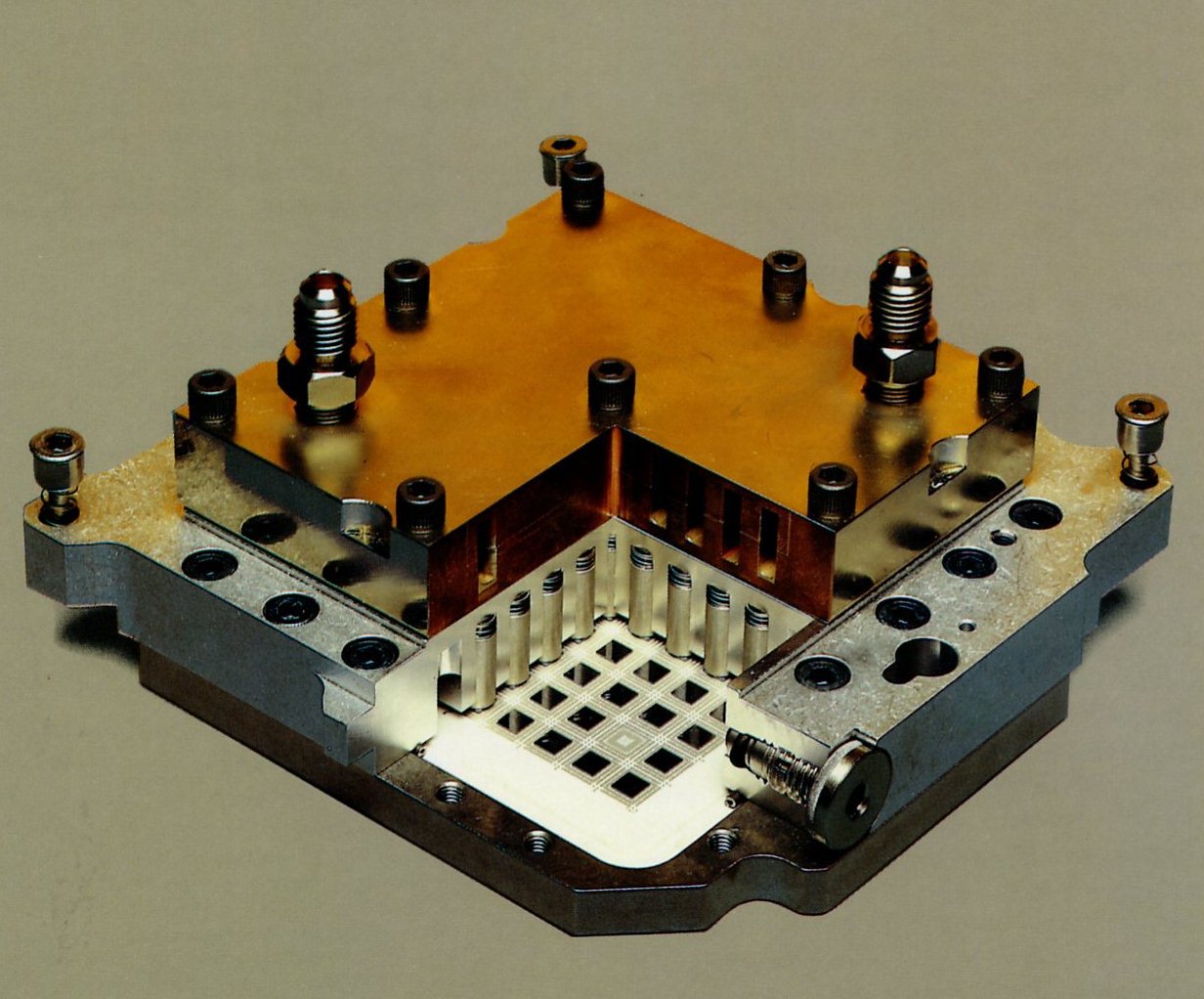
The IBM 3090 provides a wide range of growth and processing options to permit you to tailor your initial configuration to your requirements and expand it later as required. Scalar processing power can be increased by field-upgrading the uniprocessor Model 120E to the six-way Model 600E, an up to ten-fold growth path. Vector processing power can be added in sis increments.
Each Vector Facility can increase the throughput of its associated central processor one-and-a-half to three-fold for vectorisable programs.
Processor storage options from 4 Mw (32 Mb) to 160 Mw (1280 Mb) and channel options from 16 to 128 channels are also available.
Users need high availability with a computer as powerful as the IBM 3090. That makes IBM's determination to provide better availability with each successive generation of products very important for engineers, scientists and analysts contemplating the purchase of an IBM 3090. The excellent world-wide availability of IBM's 308X provides the benchmark for the 3090, whose quality has been confirmed from the time of the first installations in 1985.
The high-speed Emitter Coupled Logic (ECL) chips, which are used to create the circuits of the IBM 3090 and its optional Vector Facilities, are connected to their multilayer ceramic substrate by IBM-developed controlled-collapse chip connections. This technique, used for over 20 years, has stood the test of time and provides a durable bond. Interchip connections are established via printed conductors embedded in the multiple layer of the IBM-developed ceramic substrate, kiln-fired to form a single solid block. The substrate is mounted in an IBM Thermal Conduction Module (TCM) which provides a stable operating environment via water cooling, while protecting the chips and connections from corrosion in a sealed helium gas filled space.
The TCMs are plugged into TCM boards via zero-insertion-force spring connectors which permit easy removal of TCMs for upgrades, engineering changes or repairs while ensuring effective connection to the boards. The multilayer epoxy/glassfibre printed-circuit boards provide reliable connections to other TCMs on the same board. Connections between boards and other functional units of the processor unit are made with short multiwire cables.
The IBM 3092 Processor Controller forms part of a 3090 processor complex and performs monitoring, error logging, reconfiguration and diagnostic functions. It works with the 3090 to achieve automatic error recovery whenever possible. In the case of an unrecoverable failure, sections of processor storage, complete central processors and channels can be taken off line; often without interruption to processing.
Built-in diagnostics allow the 3092 to perform error diagnostics in parallel with 3090 operation. The operator is alerted when a serious problem occurs and, using interactive customer Problem Analysis, can often restart the system. In the case, of a solid 3090 failure, the 3092 can transmit fault and diagnostic information to a remote service centre, from where specialists can exercise the 3090 if further diagnosis is required. Usually the 3092 correctly identifies the failing part and enables the IBM customer engineer to repair the fault quickly.
The IBM 3090 reflects IBM's policy of manufacturing products in Europe. For example: the memory chips, TCM substrates and TCM board are made in Germany. The system consoles are built in the United Kingdom. The logic chips are made in France, where final assembly and testing of the IBM 3090, its TCMs and TCM boards also takes place. Supplying IBM's plants are many European companies whose contributions range from the keytops for the system consoles to the complete frames of the processor units. All of which demonstrates IBM's positive and continuous! developing contribution to the European economy.
Each year, IBM makes significant investments in fundamental and applied research and development, related to all aspects of information processing and its application in today's world. This work is carried out in research and development facilities throughout the world, and results in new products, new manufacturing processes, and new applications of computing. The development and dissemination of much this of work is shared with scientific and industrial communities to promote the further application and understanding of advanced technology.
Austin: Personal computers and low-cost workstation
Boca Raton: Low-cost personal computers, small systems, modular products, specialised applications.
Boulder: Printers.
Burlington: Semi-conductor components.
Charlotte: Printers and financial systems.
Danbury: Scientific instrumentation and application programs.
East Fishkill: Semi-conductor components and ceramic substrates.
San Jose: Disk storage systems.
Santa Teresa: Software and programming aids.
Tucson: Magnetic tape systems, disk storage units and printers.
Westlake: Space programs.
Toronto: National language adaptation and programming support.
Fujisawa: Handling of uncoded data, interactive display systems.
Yorktown Heights (USA): Fundamental, technological and applied research in the fields of physics, mathematics, and semi-conductors.
San Jose (USA): Fundamental, technological and applied research into physics, computer science and data storage systems.
Zurich (Switzerland): Fundamental and technological research into solids, communications and computer science.
Corbeil-Essonnes (near Paris): Very Large Scale Integration (VLSI) logic and high speed memory semi-conductor components.
La Gaude (near Nice): Telecommunications systems, signal processing, communications controllers, data communications, data networks.
Boeblingen (near Stuttgart): Medium range computer systems and processors, operating systems, high speed printers, Very Large Scale Integration (VLSI) semi-conductor components, finance systems, man-machine- communications, scientific pilot projects.
Sindelfingen (near Stuttgart): Software development for computer-aided publishing, information retrieval, videotex, industrial, financial and cross-industry applications, networking.
Rome: Software development for project management, linear programming, production planning, application development productivity, distributed systems support, text management.
Hursley (near Winchester): Graphic display products and programming, communications programming, low-cost disk storage, advanced display technology.
IBM maintains a strong link with academic and scientific organisations in Europe, to explore the use of new data processing techniques, as applied to scientific problems. Centres in Bergen, Heidelberg, Madrid, Paris, Pisa, Rome and Winchester carry out work in areas such as applied mathematics, computer science, expert systems, digital image processing, earth and environmental sciences, medical applications, speech and text processing. The numerically intensive computing facility in Rome, called the European Centre for Scientific/Engineering Computing, assists European scientists and analysts in carrying out advanced research in such areas as quantum chemistry, fluid dynamics, seismology and economics. In addition the centre has facilities for practical experimentation with parallel and vector processing using an IBM 3090. The Bergen Scientific Centre also has an IBM 3090 with vector processing capability, used for oil industry and marine research projects.